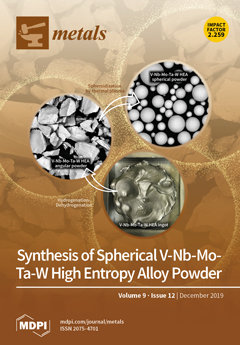The non-isothermal crystallization characteristics of the electroslag remelting (ESR)-type slag with varied B
2O
3 contents were investigated by non-isothermal differential scanning calorimetry (DSC), field emission scanning electron microscopy (SEM-EDS), and X-ray diffraction (XRD). The crystallization mechanism of the B
2O
[...] Read more.
The non-isothermal crystallization characteristics of the electroslag remelting (ESR)-type slag with varied B
2O
3 contents were investigated by non-isothermal differential scanning calorimetry (DSC), field emission scanning electron microscopy (SEM-EDS), and X-ray diffraction (XRD). The crystallization mechanism of the B
2O
3-bearing slag was also identified based on kinetics analysis. The results showed that the primary crystalline phase was CaF
2, there was no change in the type of the primary crystal as B
2O
3 content increased, and the morphology of the CaF
2 crystal was mainly dendritic. The sequence of crystal precipitation during the cooling process was CaF
2 to Ca
12Al
14O
32F
2 and MgO/MgAl
2O
4, followed by Ca
3B
2O
6. The activation energy of CaF
2 crystallization increased firstly, then decreased and reached stability, while the activation energy of Ca
3B
2O
6 crystallization increased continuously with the increasing B
2O
3 content. The crystallization behavior of CaF
2 was three-dimensional growth with a constant nucleation rate. The proper B
2O
3 content added into the CaF
2-based ESR slag should be around 1.0% to limit the precipitation of the CaF
2 crystal to attain good surface ingot quality and stable ESR operation.
Full article





